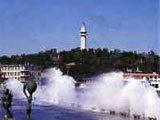 The beautiful seaside city of Yantai is one of the most popular tourist destinations in east China?s Shandong province.
The beautiful seaside city of Yantai is one of the most popular tourist destinations in east China?s Shandong province.
Yantai ranks high in prestige for the many tourists who are drawn to its unique seaside scenery and historical sites on China?s eastern coast. Situated in the central part of the Shandong Peninsula, it gazes across the sea toward Japan and South Korea. Yantai?s coastline measures about 1,300 kilometers, dotted with islands, bays and beaches, and its rich marine resources have earned it the nickname of Golden Coast.
As one of the top tourist cities in China, Yantai boasts many prime bathing spots along the sea, including both renowned summer resorts and natural landscapes.
Zhao Yuhao, vice director of the Press Office of Yantai City, speaks of its booming tourism:
?The city has enormous potential for tourism. Its many sightseeing attractions feature the Penglai Pavilion, ?fairyland on earth?, and Yantai Hill, symbol of the city.?
Penglai, one of Yantai?s cities, was called Dengzhou in ancient times. Located on a promontory into the sea, the town appears to emerge from the waves amid the foam and mist. As mirages are often seen in the area, Penglai has been given the name "Wonderland".
Situated on Mountain Redcliff and rising abruptly from the northern seashore of Penglai City, Penglai Pavilion is one of the ?four well-known ancient Chinese Pavilions?.
Penglai Pavilion is a historical architectural complex with the Pavilion as its principal structure. It consists of Penglai Pavilion, Luzu Temple, Sanqing Temple, the Palace of the Celestial Queen and other architectural units, each surrounded by towers, halls, pavilions and terraces.
Most miraculous is the Wind-sheltering Pavilion, standing high on the mountain peak, facing the sea. Even with all its doors and windows open wide, not a vestige of wind can be felt in the pavilion, and candles never blow out, no matter how strongly the sea wind blows. Other spectacular sights of Penglai Pavilion are the fantastic mirages which appear above the sea.
Jiang Ziguang is a sightseeing guide for Penglai Pavilion:
"Penglai Pavilion attracts nearly two million tourists from all over the world every year. With an annual tourist income of eight million yuan, or about one million US dollars, it is among one of the four economic mainstays in Penglai.?
Another prestigious landscape is Yantai Hill, bordering the sea to the north and the land to the south. It is known for its beautiful environment and splendid view. The Hill was originally named for its smoke tower in the early Ming Dynasty, erected to guard against foreign intruders. Today, the "Yantai Stone" and a navigation light tower stand firmly on the hill, overlooking the precipice.
"Relang Pavilion", east of the hill, is nested between mountain and sea. On a clear day, you can see the mountains in the distance past the sea, and if it?s windy enough, you can even see the waves crashing down on the sandy shores at their feet.
Li Ting, a tourist from Beijing, has visited Yantai Hill for the first time:
?The scene is gorgeous! I will tell all my friends to visit the Hill. From here I can see the whole city.?
As one of the first 14 coastal cities open to the world, Yantai is also a leading city in the Economic Circle of the Bohai Sea to which the Chinese government attaches particular importance.
The tourist income accounts for a substantial part of the city?s total revenue. Li Quan, a senior official with the Yantai Tourism Bureau, talks about the total amount of annual tourist income:
?The annual tourist income in 2001 was nearly 7 billion yuan, or 800 million US dollars, with a growth of 18 percent over the same period last year. And it occupies seven percent of the city?s gross national product.?
He adds that Yantai has also prioritized and accelerated the construction of tourist service facilities, in order to attract even more visitors from both China and abroad. Their goal is to present the world with an even more beautiful Yantai.
|

